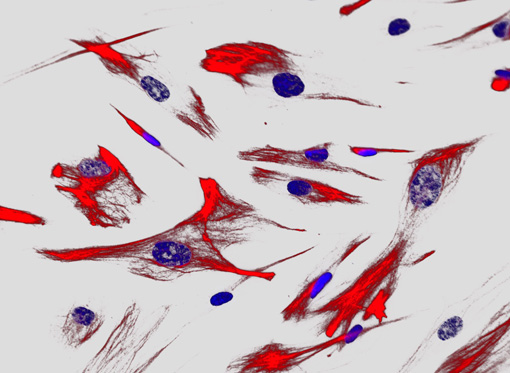
Astrocytes reborn. Scientists regenerated astrocytes from people with either familial or sporadic ALS from precursor cells isolated from post-mortem samples of the spinal cord. Courtesy of Brian K. Kaspar, Ph.D.
Astrocytes protect and mediate the repair of motor nerves. But in people with ALS, astrocytes ignite a storm of inflammatory cytokines that results instead in their destruction.
Now, researchers at Nationwide Children’s Hospital in Ohio hope to figure out how astrocytes trigger deterioration of the motor nerves in people with ALS by recreating the disease in laboratory dishes. Their system which involves co-culturing motor neurons with astrocytes derived from people with ALS is the first to recreate in the laboratory the sporadic form of the disease.
“We can start studying the molecular mechanisms and the cell biology happening,” says Nationwide Children’s Hospital neuroscientist Brian Kaspar, PhD.
The study is published in the September issue of Nature Biotechnology.
Scientists isolated neural precursors from post-mortem tissue samples obtained from patients with either the familial (fALS) or sporadic (sALS) form of the disease. The team found that astrocytes generated from either fALS or sALS precursors resulted in degeneration of mouse motor neurons. These results suggest that astrocytes contribute to the deterioration of the motor nerves even in people with the sporadic form of the disease.
Now, Kaspar’s team is developing methods to recreate ALS using motor neurons derived from people with ALS. And in future years, the researchers hope to include other neighboring cells in the central nervous system including microglia and oligodendrocytes to truly recreate the disease.
Looking ahead, these cellular tools could be used to discover new ALS drugs by screening for compounds that protect motor neurons from degeneration. And says Kaspar, this system could be used to unravel the mechanisms behind the disease.
“Not too long ago we thought motor neurons were the problem,” says Kaspar, “Now we have lists of cells we are paying attention to.”
References
Haidet-Phillips, A.M. et al. (2011) Astrocytes from familial and sporadic ALS patients are toxic to motor neurons. Nature Biotechnology,29(9), 824-8. Abstract | Full Text (Subscription Required)
Further Reading
Di Giorgio, F.P., Boulting, G.L., Bobrowicz, S., and Eggan, K.C. (2008). Human embryonic stem cell-derived motor neurons are sensitive to the toxic effect of glial cells carrying an ALS-causing mutation. Cell Stem Cell, 3(6), 637-648. Abstract | Full Text (Subscription Required)
Marchetto, M.C., Muotri, A.R., Mu, Y., Smith, A.M., Cezar, G.G., and Gage F.H. (2008). Non-cell-autonomous effect of human SOD1 G37R astrocytes on motor neurons derived from human embryonic stem cells. Cell Stem Cell, 3(6), 649-657. Abstract | Full Text (Subscription Required)